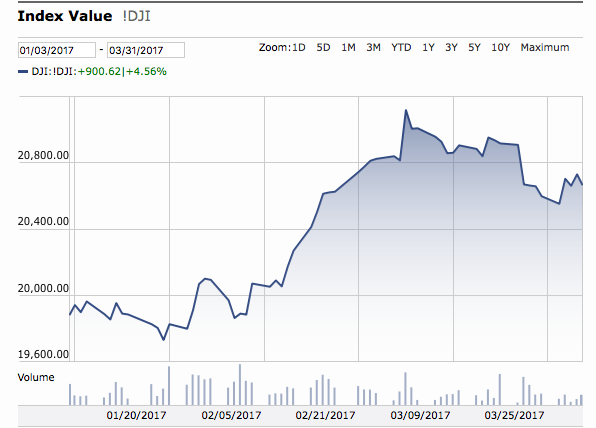The 2019 Third Quarter Market Results Were Basically Flat. What Can We Deduce – if Anything – from Those Results?
As I’ve said in the past, one of the reasons I write quarterly updates is to bring financial trends into focus.
The financial headlines chronicle the daily and weekly gyrations of the markets, but when smoothed out, what are those actions really saying?
2019’s third quarter saw a bumpy road, especially throughout the month of August, the result of a number of economic signals that may, or may not, result in the outcomes the markets thought at the time.
The major mover of the markets in August had to do with what’s called an inverted yield curve. I won’t get into the specifics of what an inverted yield curve is…you can click the link to read more if you like…other than to say when it occurs, it has, historically, sometimes been an indicator of a coming economic downturn or recession.
The markets didn’t like the fact that an inverted yield curve manifested and showed their displeasure and angst over a pending downturn in the U.S. economy by selling off.
Once the hysteria subsided, though, the markets shrugged off the doldrums, especially since the yield curve did not stay inverted for too long (a requirement for an inversion to really be considered a harbinger of things to come) and bounced back to pre-concern levels.
Now, let’s take a look at those levels and the gyrations the markets took to get there.
2019 Third Quarter Returns
The Dow Jones Industrial Average increased just 74.63 points or 0.75%.

The S&P 500 rose 41.86 points for a 0.42% increase.

And the Nasdaq dropped 135.35 points for a 1.35% loss.

As I said in the title, basically a flat quarter for all three indices.
Although it could be said the Nasdaq took the brunt of the negative news this past quarter, leading to a slightly weaker outcome for Q3.
How do we interpret the actions of the markets in the third quarter of 2019?
Here are my thoughts.
2019 Going Forward
While recessionary signals were the cause of much of Q3’s market movements, they weren’t the only thing causing disquiet.
As I’ve mentioned in previous quarterly updates, global economic weakness, which was prevalent through 2019’s Q3, and still today, is a major concern for markets.
And while the U.S. economy has stood strong in the face of the global slowdown, a few cracks here and there are being seen.
A related issue, trade negotiations, primarily with China, is also causing market consternation. China’s economy is slowing significantly, a combination of trade issues and the worldwide economic slowdown and that is worrying the markets as it relates to U.S. corporate profits for businesses that have a decent amount of exposure in the China market.
So, the question remains, as it has for months now, how much will the global economic slowdown hit the U.S. economy?
Another issue that has moved, and will continue to move, the markets is actions by the Federal Reserve Bank.
As expected, the Federal Reserve Bank lowered interest rates, twice, during the third quarter. The reason? Basically, the reasons I mentioned above. The cuts can be viewed as an individual taking a lot of vitamin C as cold season approaches. Preventative, to stave off what may happen. In this case, contagion from the overseas’ slowdowns.
In my last quarterly update I said:
“Should the Federal Reserve begin cutting interest rates, the markets likely will move a bit higher…but maybe not that much due to the cuts are already being factored in by much of the investment community.”
Considering there was a cut August 1, 2019, and then again September 19, 2019, and looking at the charts above, I’d say that pretty much hit the nail on the head.
Future Fed interest rate cuts likely won’t move the markets significantly, either, and it will be questionable whether or not they’ll stabilize the U.S. economy, should a slowdown begin to make an appearance.
Another factor, now that we’re moving into fall 2019, is the 2020 presidential election.
Yes, that may sound ridiculous, but it’s an unfortunate reality that a year out, business and the stock markets may begin to just put things on hold until the election results are known.
Which means, barring major economic-related upheavals, the markets may well hold around their current levels for the next year or so.
Not ideal for those counting on robust stock market returns – government and private sector pension funds and those building a retirement nest egg to name a couple – but a positive when we consider all the economic and geopolitical choppiness we’re seeing around the world.
The upcoming corporate earnings forecasts will tell us much about what may be in store for the U.S. economy.
Luckily, the U.S. job market and consumer spending remain strong.
If they stay that way, things should remain positive for the U.S.
If the strength wanes, however, the question will then become how deep will the downturn become?
And now to my typical close to these quarterly updates…
We at Savings Beagle are not investment advisors. It’s not our goal to encourage you to put your money into the markets, or to sell if you already have invested.
Rather, it’s to provide information to help illustrate the current state of the U.S. markets which can help guide your financial decisions.
Saving money – whether by investing in stocks, bonds or by simply putting a set amount into a savings account on a regular basis – is critical to your future financial well-being.
And we’re here to relay money saving deals and tips to make finding that excess cash that you can put to work a little easier.
If you haven’t already, bookmark our site, follow us on Facebook, join us on Twitter or subscribe to our posts to ensure you receive every savings opportunity we’re able to pass along.
Saving money and planning for the future’s hard – we’re here to help make it a little easier.
Stock charts courtesy of Morningstar.com



